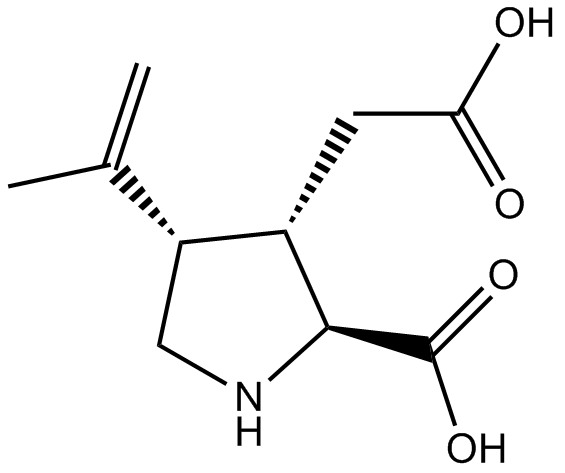Kainic acid |
| Catalog No.GC16667 |
Kainic acid (KA), is an analog of the excitotoxic neurotransmitter glutamate. Kainic acid induces seizures.
Products are for research use only. Not for human use. We do not sell to patients.

Cas No.: 487-79-6
Sample solution is provided at 25 µL, 10mM.
Kainic acid (KA), is an analog of the excitotoxic neurotransmitter glutamate. Kainic acid induces seizures[1-3].
Kainic acid(200 µM; 45 min) exposure induced caspase and calpain activation in neuronal cultures[4]. Kainic acid(5 µM) induces seizure-like activity in cortical human neurons[5]. Treatments with KA(1-100 µM) resulted in a significant decrease in cell viability in primary cultures of hippocampal neurons [6].
KA-induced(10 mg/kg;i.p) excitotoxicity led to sustained hyperphosphorylation of tau in MAPT transgenic (Tg) mice. This can lead to memory deficits[7]. After 1.0 µg of Kainic acid was injected into the hippocampus of young mice at 6, 7 and 9 days of age, pyramidal cells died significantly [8]. Injection of Kainic acid(70 µl/min; 16 mg/kg;i.v) through the tail vein of a mouse reliably and rapidly induces status epilepticus (SE) which remits spontaneously and leads to the development of temporal lobe epilepsy (TLE) in a subset of mice[9].
References:
[1]. LÉvesque M, Avoli M. The kainic acid model of temporal lobe epilepsy. Neurosci Biobehav Rev. 2013 Dec;37(10 Pt 2):2887-99. doi: 10.1016/j.neubiorev.2013.10.011. Epub 2013 Oct 30. PMID: 24184743; PMCID: PMC4878897.
[2]. Ben-Ari Y, Cossart R. Kainate, a double agent that generates seizures: two decades of progress. Trends Neurosci. 2000 Nov;23(11):580-7. doi: 10.1016/s0166-2236(00)01659-3. PMID: 11074268.
[3]. Barker-Haliski M, White HS. Glutamatergic Mechanisms Associated with Seizures and Epilepsy. Cold Spring Harb Perspect Med. 2015 Jun 22;5(8):a022863. doi: 10.1101/cshperspect.a022863. PMID: 26101204; PMCID: PMC4526718.
[4]. Meade AJ, Meloni BP, et,al. AP-1 inhibitory peptides attenuate in vitro cortical neuronal cell death induced by kainic acid. Brain Res. 2010 Nov 11;1360:8-16. doi: 10.1016/j.brainres.2010.09.007. Epub 2010 Sep 15. PMID: 20833150.
[5]. Mzezewa R, Lotila J, et,al. A kainic acid-induced seizure model in human pluripotent stem cell-derived cortical neurons for studying the role of IL-6 in the functional activity. Stem Cell Res. 2022 Apr;60:102665. doi: 10.1016/j.scr.2022.102665. Epub 2022 Jan 17. PMID: 35091307.
[6]. RodrÍguez-ChÁvez V, Flores-Soto E, et,al. Prolactin reduces the kainic acid-induced increase in intracellular Ca2+ concentration, leading to neuroprotection of hippocampal neurons. Neurosci Lett. 2023 Jul 27;810:137344. doi: 10.1016/j.neulet.2023.137344. Epub 2023 Jun 13. PMID: 37315731.
[7]. Zheng XY, Lv YD, et,al. Kainic acid hyperphosphorylates tau via inflammasome activation in MAPT transgenic mice. Aging (Albany NY). 2019 Dec 2;11(23):10923-10938. doi: 10.18632/aging.102495. Epub 2019 Dec 2. PMID: 31789603; PMCID: PMC6932880.
[8]. Cook TM, Crutcher KA. Intrahippocampal injection of kainic acid produces significant pyramidal cell loss in neonatal rats. Neuroscience. 1986 May;18(1):79-92. doi: 10.1016/0306-4522(86)90180-6. PMID: 3736859.
[9]. Drysdale ND, Matthews E, et,al. Intravenous kainic acid induces status epilepticus and late onset seizures in mice. Epilepsy Res. 2021 Dec;178:106816. doi: 10.1016/j.eplepsyres.2021.106816. Epub 2021 Nov 14. PMID: 34808484; PMCID: PMC8657370.
Average Rating: 5 (Based on Reviews and 25 reference(s) in Google Scholar.)
GLPBIO products are for RESEARCH USE ONLY. Please make sure your review or question is research based.
Required fields are marked with *




















